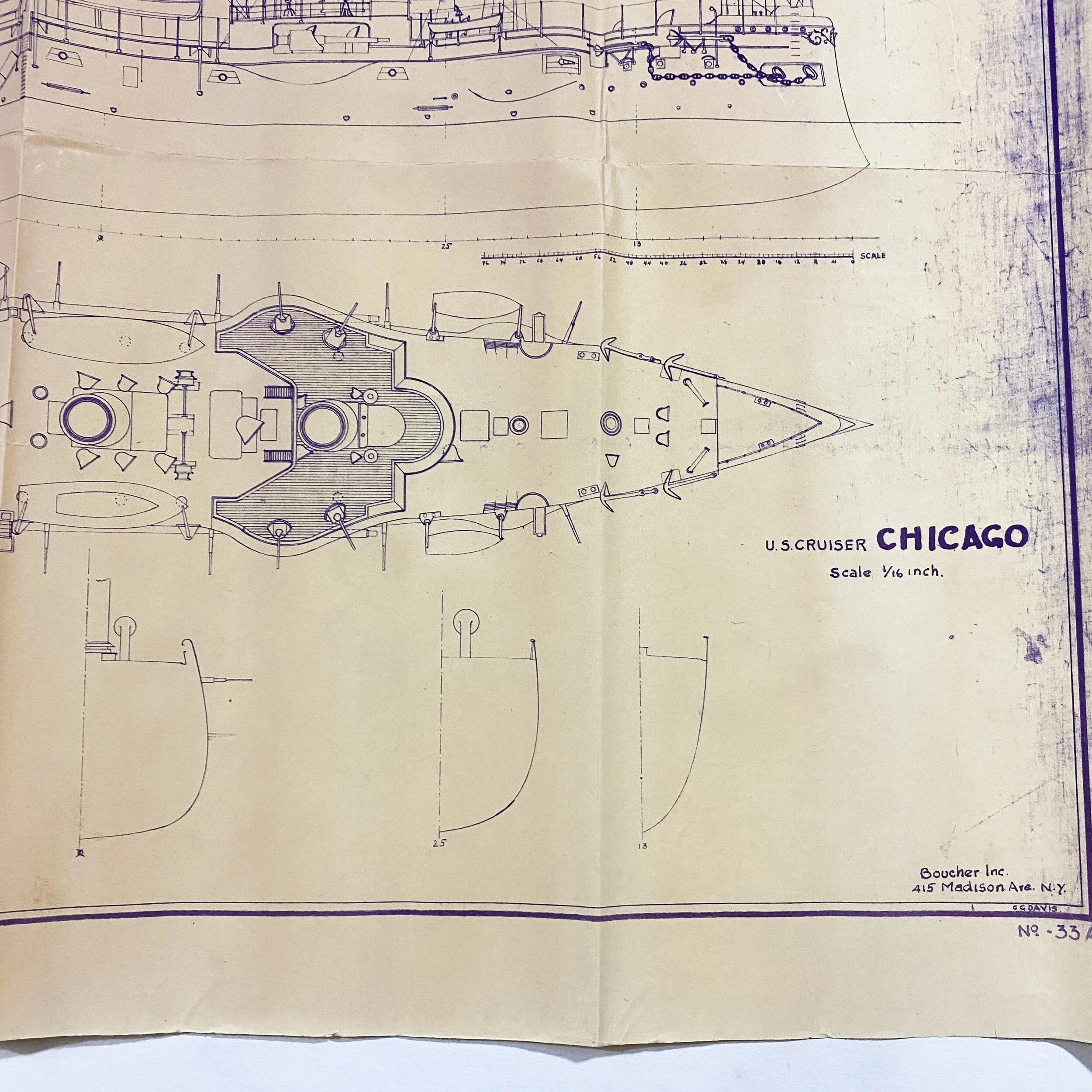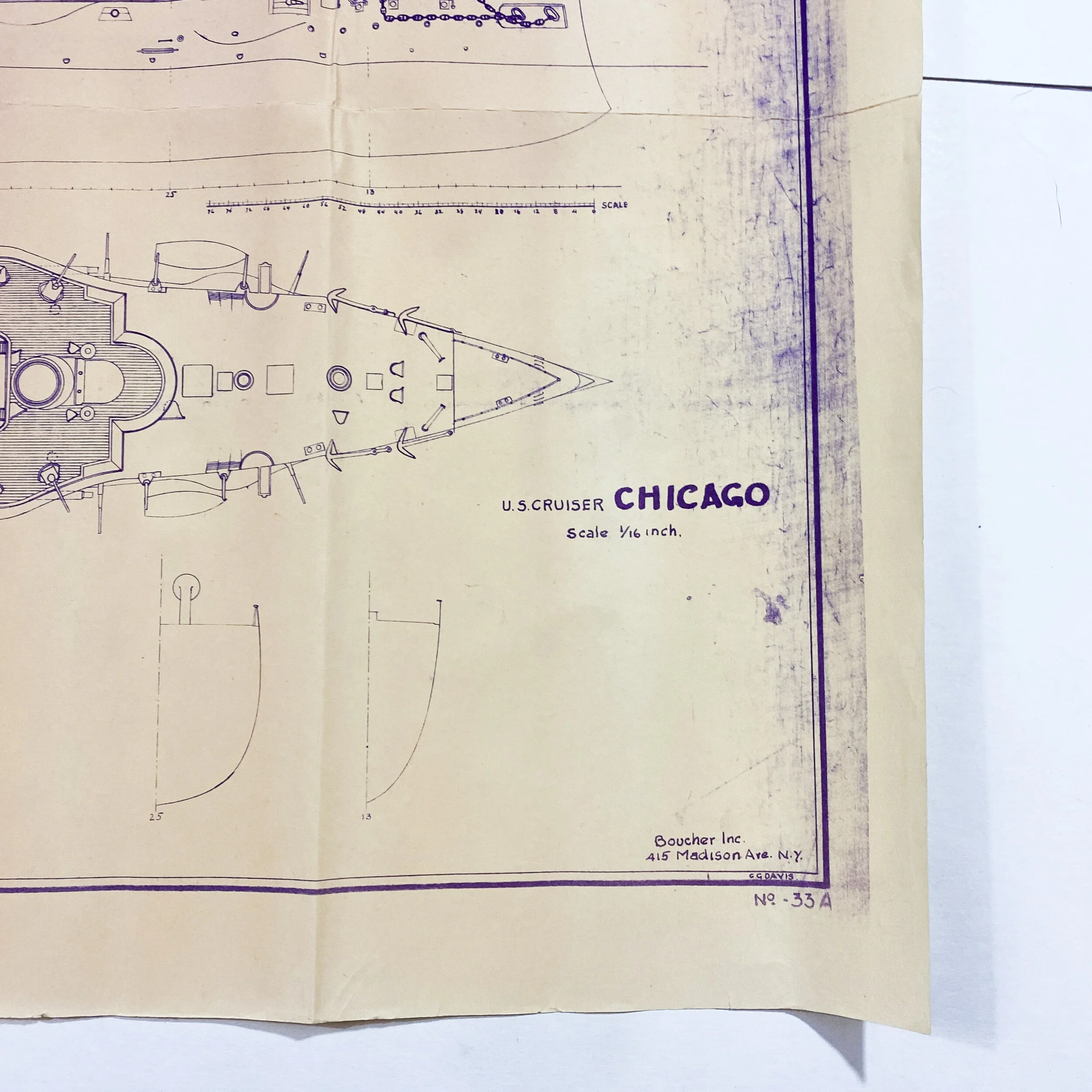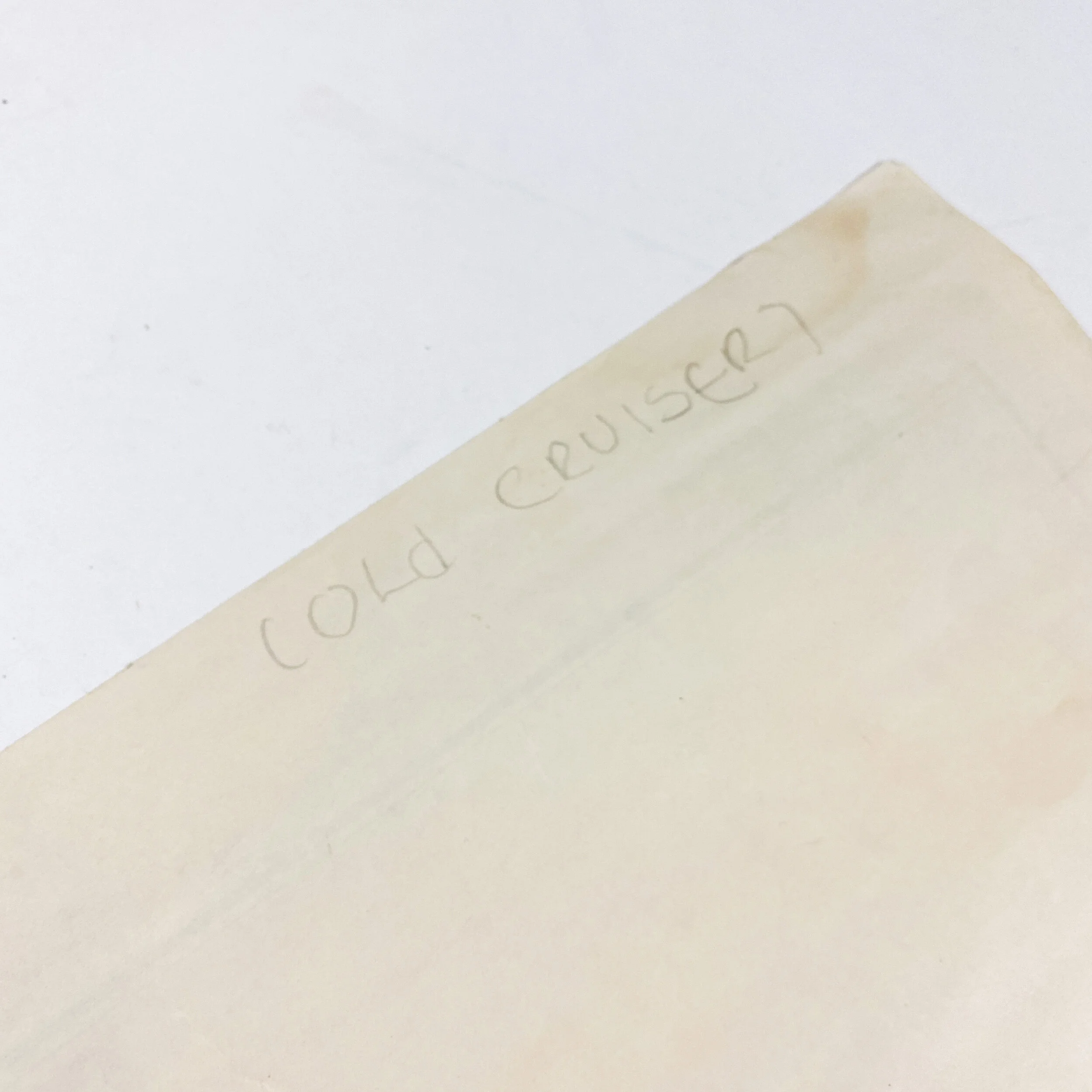Vintage - U.S. Cruiser Chicago Layout Blueprint - Drawing 33A - Boucher Inc.























Vintage - U.S. Cruiser Chicago Layout Blueprint - Drawing 33A - Boucher Inc.
Size: 23 x 30 inches
This blueprint comes from the blueprint collection of the famous Edward H. Wiswesser. From 1940-1946, Edward H. Wiswesser worked at the Philadelphia Naval Yard designing warships for the United States Navy, specializing in Iowa-class battleships including his direct hand in designing the Battleships USS New Jersey and the USS Wisconsin. His design of the USS New Jersey was one of the Iowa-class "fast battleship" designs planned in 1938 by the Preliminary Design Branch at the Bureau of Construction and Repair. She was launched on December 7th of 1942 (the first anniversary of the attack on Pearl Harbor) and was commissioned on 23 May 1943. The ship was the second of the Iowa class to be commissioned by the U.S. Navy. The USS New Jersey (BB-62) ("Big J" or "Black Dragon") was the second ship of the United States Navy to be named after the US state of New Jersey. New Jersey earned more battle stars for combat actions than the other three completed Iowa-class battleships, and was the only US battleship providing gunfire support during the Vietnam War. During World War II, New Jersey shelled targets on Guam and Okinawa, and screened aircraft carriers conducting raids in the Marshall Islands. Edward H. Wiswesser other design of the USS Wisconsin (BB-64) is an Iowa-class battleship, the second ship of the United States Navy to be named in honor of the U.S. state of Wisconsin. She was built at the Philadelphia Naval Shipyard in Philadelphia, Pennsylvania and launched on December 7, 1943 (the second anniversary of the Pearl Harbor raid), sponsored by the wife of Governor Walter Goodland of Wisconsin. During her career, Wisconsin served in the Pacific Theater of World War II, where she shelled Japanese fortifications and screened United States aircraft carriers as they conducted air raids against enemy positions.
This specific blueprint is labeled as drawing number 33A and is titled “U.S. Cruiser Chicago’. The blueprint itself is from Boucher Inc. based in New York. The blueprint contains some of the most detailed and intricate constructional layouts of the ship as well as detailed measurements of its length, arraignment, guns and turret attachments. While this blueprint is not of a WWII era ship, it was most likely used as a study blueprint of past Naval ships as Edward H. Wiswesser designed WWII era ships for the Navy.
USS Chicago:
The first USS Chicago (later CA-14) was a protected cruiser of the United States Navy, the largest of the original three authorized by Congress for the "New Navy". One of the U.S. Navy's first four steel ships.
Chicago was built with a displacement of 4,500 long tons (4,600 t) at an overall length of 342 ft 2 in (104.29 m) and 325 ft (99 m) at the perpendiculars. Her beam was 48 ft 3 in (14.71 m) with a draft of 19 ft (5.8 m). She had fourteen 100psi boilers that ran two compound overhead beam steam engines that producing 5,084 ihp (3,791 kW) to turn her two screws and achieve a speed of 14 kn (16 mph; 26 km/h). She was also rigged with sails as a barque. Chicago was capable of carrying 830 short tons (750 t) of coal.
Chicago's original armament consisted of four 8-inch (203 mm)/30 caliber Mark 2 guns,[3] eight 6-inch (152 mm)/30 caliber Mark 2 guns, two 5-inch (127 mm)/31 caliber Mark 1 guns,[4] two 6-pounder 57 mm (2.24 in) guns, four 3-pounder 47 mm (1.85 in) guns, two 1-pounder 37 mm (1.46 in) Hotchkiss revolver cannon, and two .45 caliber (11.4 mm) Gatling guns.
She had 4 in (100 mm) of armor on her gun shields, 1.5 in (38 mm) on her deck, and 3 in (76 mm) on her conning tower.
On 7 December 1889, Chicago departed Boston for Lisbon, Portugal, arriving on 21 December. The cruiser served in European and Mediterranean waters as the flagship of the Squadron of Evolution until 31 May 1890, when she sailed from Funchal, Madeira to call at Brazilian and West Indian ports before returning to New York on 29 July.
Chicago operated along the east coasts of North and South America and in the Caribbean as flagship of the Squadron of Evolution—and later as flagship of the North Atlantic Squadron—until 1893. After taking part in the International Naval Review in Hampton Roads in April, she left New York on 18 June 1893 to cruise in European and Mediterranean waters as flagship of the European station. During this period the ship was commanded by Alfred Thayer Mahan, already famous as a naval strategist. Chicago returned to New York on 20 March 1895, and was placed out of commission there on 1 May.
Recommissioned on 1 December 1898, Chicago made a short cruise in the Caribbean before sailing for the European Station on 18 April. She returned to New York on 27 September and participated in the naval parade and Dewey celebration of 2 October 1899. Chicago sailed from New York on 25 November for an extended cruise, as flagship of the South Atlantic Station until early July 1901, then as flagship of the European Station. With the squadron, she cruised in northern European, Mediterranean, and Caribbean waters until 1 August 1903, when she proceeded to Oyster Bay, New York, and the Presidential Review.
From 3 December 1903 – 15 August 1904, Chicago was out of commission at Boston undergoing repairs. After operating along the northeast coast, the cruiser departed Newport News on 17 November for Valparaíso, Chile, arriving on 28 December. There, on 1 January 1905, she relieved the armored cruiser New York as flagship of the Pacific Squadron and for three years operated off the west coasts of North and South America, in the Caribbean, and to Hawaii. In 1906, she played a key role in the evacuation of San Francisco during the 1906 San Francisco earthquake. Arriving from San Diego at 6pm on April 19, Chicago's radio allowed the city's leadership to communicate with the outside world, as telephone and telegraph lines were down. A group of two officers and sixteen enlisted men from Chicago supervised waterborne evacuation efforts. The removal of 20,000 refugees to Tiburon in Marin County by this ship and numerous other vessels is said to be unparalleled and unsurpassed until the 1940 evacuation of Dunkirk.
On 8 January 1908, Chicago departed San Diego for the east coast and in May joined the Naval Academy Practice Squadron for the summer cruise along the northeast coast until 27 August, when she went into reserve. Chicago was recommissioned the next summer (14 May-28 August 1909) to operate with the Practice Squadron along the east coast, then returned to Annapolis. On 4 January 1910, she left the Academy for Boston, arriving on 23 January. She then served "in commission in reserve" with the Massachusetts Naval Militia until 12 April 1916, and with the Pennsylvania Naval Militia from 26 April 1916 – April 1917.